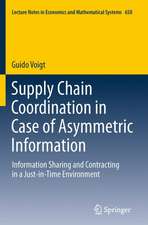The Economics of Made-to-Order Production: Theory with Applications Related to the Airframe Industry: Lecture Notes in Economics and Mathematical Systems, cartea 261
Autor Thomas R. Gulledge, Norman K. Womeren Limba Engleză Paperback – 1986
Din seria Lecture Notes in Economics and Mathematical Systems
-
 Preț: 360.02 lei
Preț: 360.02 lei -
 Preț: 383.93 lei
Preț: 383.93 lei - 15%
 Preț: 693.39 lei
Preț: 693.39 lei -
 Preț: 384.09 lei
Preț: 384.09 lei -
 Preț: 380.07 lei
Preț: 380.07 lei -
 Preț: 446.26 lei
Preț: 446.26 lei -
 Preț: 497.37 lei
Preț: 497.37 lei -
 Preț: 380.84 lei
Preț: 380.84 lei -
 Preț: 384.86 lei
Preț: 384.86 lei -
 Preț: 378.34 lei
Preț: 378.34 lei -
 Preț: 399.67 lei
Preț: 399.67 lei - 20%
 Preț: 360.93 lei
Preț: 360.93 lei - 15%
 Preț: 643.16 lei
Preț: 643.16 lei -
 Preț: 379.09 lei
Preț: 379.09 lei -
 Preț: 404.76 lei
Preț: 404.76 lei -
 Preț: 385.62 lei
Preț: 385.62 lei - 15%
 Preț: 644.49 lei
Preț: 644.49 lei -
 Preț: 379.09 lei
Preț: 379.09 lei -
 Preț: 345.50 lei
Preț: 345.50 lei -
 Preț: 425.80 lei
Preț: 425.80 lei -
 Preț: 378.34 lei
Preț: 378.34 lei - 18%
 Preț: 775.65 lei
Preț: 775.65 lei -
 Preț: 392.60 lei
Preț: 392.60 lei -
 Preț: 401.61 lei
Preț: 401.61 lei - 15%
 Preț: 646.43 lei
Preț: 646.43 lei -
 Preț: 382.18 lei
Preț: 382.18 lei -
 Preț: 378.34 lei
Preț: 378.34 lei - 15%
 Preț: 637.59 lei
Preț: 637.59 lei - 15%
 Preț: 647.27 lei
Preț: 647.27 lei -
 Preț: 377.73 lei
Preț: 377.73 lei -
 Preț: 447.84 lei
Preț: 447.84 lei - 15%
 Preț: 644.49 lei
Preț: 644.49 lei -
 Preț: 386.00 lei
Preț: 386.00 lei - 15%
 Preț: 654.43 lei
Preț: 654.43 lei -
 Preț: 415.02 lei
Preț: 415.02 lei -
 Preț: 411.54 lei
Preț: 411.54 lei -
 Preț: 398.92 lei
Preț: 398.92 lei -
 Preț: 398.92 lei
Preț: 398.92 lei -
 Preț: 392.75 lei
Preț: 392.75 lei - 15%
 Preț: 635.47 lei
Preț: 635.47 lei - 20%
 Preț: 653.56 lei
Preț: 653.56 lei -
 Preț: 379.86 lei
Preț: 379.86 lei -
 Preț: 495.46 lei
Preț: 495.46 lei -
 Preț: 447.99 lei
Preț: 447.99 lei -
 Preț: 378.71 lei
Preț: 378.71 lei - 15%
 Preț: 637.13 lei
Preț: 637.13 lei -
 Preț: 385.84 lei
Preț: 385.84 lei -
 Preț: 378.54 lei
Preț: 378.54 lei - 15%
 Preț: 666.55 lei
Preț: 666.55 lei
Preț: 380.84 lei
Nou
Puncte Express: 571
Preț estimativ în valută:
72.88€ • 77.93$ • 60.76£
72.88€ • 77.93$ • 60.76£
Carte tipărită la comandă
Livrare economică 18 aprilie-02 mai
Preluare comenzi: 021 569.72.76
Specificații
ISBN-13: 9783540160557
ISBN-10: 3540160558
Pagini: 148
Ilustrații: VI, 138 p.
Dimensiuni: 170 x 244 x 8 mm
Greutate: 0.25 kg
Ediția:Softcover reprint of the original 1st ed. 1986
Editura: Springer Berlin, Heidelberg
Colecția Springer
Seria Lecture Notes in Economics and Mathematical Systems
Locul publicării:Berlin, Heidelberg, Germany
ISBN-10: 3540160558
Pagini: 148
Ilustrații: VI, 138 p.
Dimensiuni: 170 x 244 x 8 mm
Greutate: 0.25 kg
Ediția:Softcover reprint of the original 1st ed. 1986
Editura: Springer Berlin, Heidelberg
Colecția Springer
Seria Lecture Notes in Economics and Mathematical Systems
Locul publicării:Berlin, Heidelberg, Germany
Public țintă
ResearchCuprins
I Introduction.- Statement of the Learning Augmented Economic Planning Problem.- Scope and Methodology.- II Historical Perspective.- The Origins of the Learning Curve.- Linking the Progress Function with Economic Theory.- Early Solutions for the Learning Augmented Planning Problem.- III Recent Results in the Analysis of Made-to-Order Production.- General Theoretical Results.- A Refinement of Alchian’s Propositions.- A Basic Model for Learning Augmented Production Analysis.- The Basic Model with a Variable Delivery Schedule.- The Importance of the Theoretical Framework.- IV Model Applications in the Airframe Industry.- Application to the C141 Airframe Program.- Production Cost Drivers.- The C141 Model.- Empirical Results.- Sensitivity Analyses.- Model Modifications and Extensions.- Summary.- V Two Production Function Model.- The Model Formulation and Solution.- Strategy for Application.- Sensitivity Analyses.- Application to the F102 Airframe Program.- VI Discrete Dynamic Cost Models.- A Dynamic Programming Model for Made-to-Order Production.- Simulations with the Dynamic Programming Model.- A Second Dynamic Programming Model for Made-to-Order Production.- A Third Dynamic Programming Model for Made-to-Order Production.- Relationships Among the Three Models.- An Application of a Discrete Dynamic Model.- Summary.- VII Empirical Production Rate Assessment Models.- Estimating Cost Impacts.- Contractor Behavior.- Summary.- VIII Summary and Conclusions.












